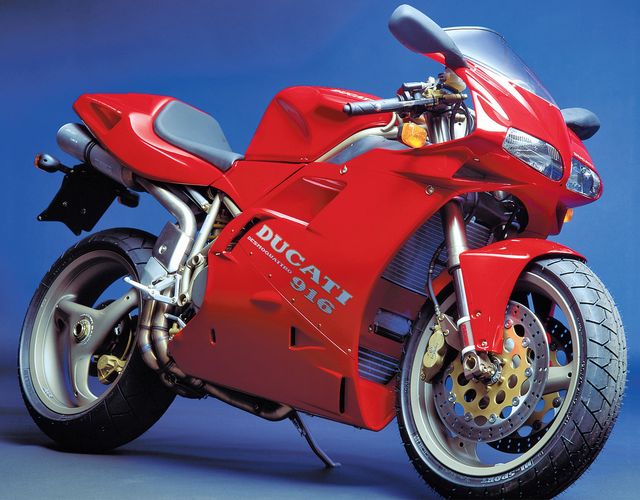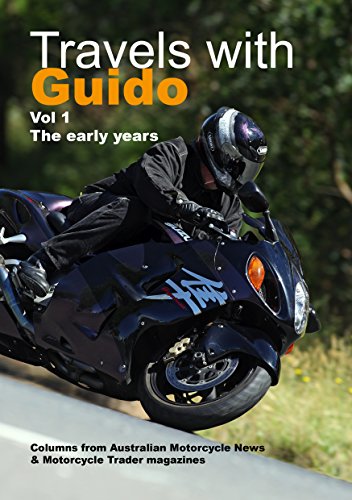Motorcycle Investor mag
Subscribe to our free email news
Ducati 916
(by Ian Falloon, Feb 2022)

Tamburini's
finest work
Only a few motorcycles can be
credited with defining an era. Honda’s first 750 Four of
1969 established a tradition of across-the-frame
four-cylinder motorcycles that continues today, and in
1994 Ducati unleashed their 916. The 916 was not only a
benchmark motorcycle for Ducati, it created a styling
blueprint for sportsbikes.
I was fortunate enough to be
given a private viewing of the 916 prototype by Massimo
Bordi at the factory in 1993 and it remains an indelible
memory. “No pictures please,” Bordi said but later one
of the employees let us in a back door to take some
illegal photos. I had never seen anything like the 916
and the features that set it apart in 1993 were so
advanced it took the opposition years to catch up.
Although the 916 looked
revolutionary with its strong frontal aspect of twin
poly-ellipsoidal headlights, single-sided swingarm, and
exhaust system exiting under the seat, it still
represented Ducati’s traditional philosophy of
evolution.
At the heart of the 916 was
the Desmoquattro 90-degree V-twin, born in 1987 as a 748
before growing to 851 and 888c. The 851 and 888 were
great Superbike racers but flawed production bikes.
When Massimo Tamburini set
about designing the 916 at the Cagiva Research Centre in
San Marino he was determined his baby would be
faultless. So while the 916 engine was essentially a
stroked 888, with the same liquid-cooled double overhead
camshaft cylinder heads and Marelli electronic fuel
injection, the rest of the motorcycle was new.
While serious consideration
was given to the twin-spar deltabox aluminium frame then
becoming popular, tradition won and Tamburini eventually
eschewed this in preference to the traditional Ducati
space frame.
From Ducati’s racing
experience with the 851 and 888, the requirements for
the 916 included a reduction in the wheelbase from the
888, yet provide as close to 50/50 weight distribution
as possible, along with adequate wheel travel. This
meant placing the front wheel as close to the engine as
possible and the engine was rotated forward 1.5° to help
the front tyre clear the cylinder head.
Tamburini was also intent on
creating an extremely strong steering head structure,
with an 80mm in outer diameter, with special bearings to
allow for a thick (35mm) steering tube. An important
element in the design was the incorporation of
adjustable caster without altering the wheelbase.
Another important
consideration in the design was a reduction in frontal
area and an improvement in aerodynamics over the
851/888. This led to the small overall size of the
motorcycle, and the shape of the fairing, fuel tank, and
seat. From above the shape was intentionally designed to
emulate the curves of a woman.
Part of the Tamburini
philosophy was to feature individually designed
components for every part of the motorcycle, even the
fasteners were not shared with the earlier 888.
The front 43mm Showa triple
clamps were machined in pairs, the chill-cast lower
triple clamp notable for its exceptional depth. In the
early 1990s Ducati still dreamed of winning the both the
Suzuka Eight-hour race and the Bol d’Or, so the 916 was
designed with a single-sided swingarm to allow for rapid
wheel changes.
The 916 produced 114
horsepower at 9000 rpm but sheer power wasn’t what the
916 was about. Although capable of 260km/h, there were
faster and more powerful motorcycles available. The 916
offered more than engine performance and provided a
balance between the engine and chassis that set new
standards. Unlike most earlier Ducatis there was a
homogeneity about the design that took the 916 into
another dimension.
What the 916 for Ducati was
take the company beyond that of an enthusiast niche
market manufacturer to that of the creator of a
universally admired and desirable motorcycle.
Since its release in 1994 the
916 went on to become arguably the greatest Ducati ever.
Providing the class-leading standard for close to a
decade no other Ducati had such success on the track for
such a long period and remained at the top of the
performance world for so long.
See the
Bikesales story on buying 1990s classics
-------------------------------------------------
Produced by AllMoto abn 61 400 694 722
Privacy: we do not collect cookies or any other data.

Archives
Contact





